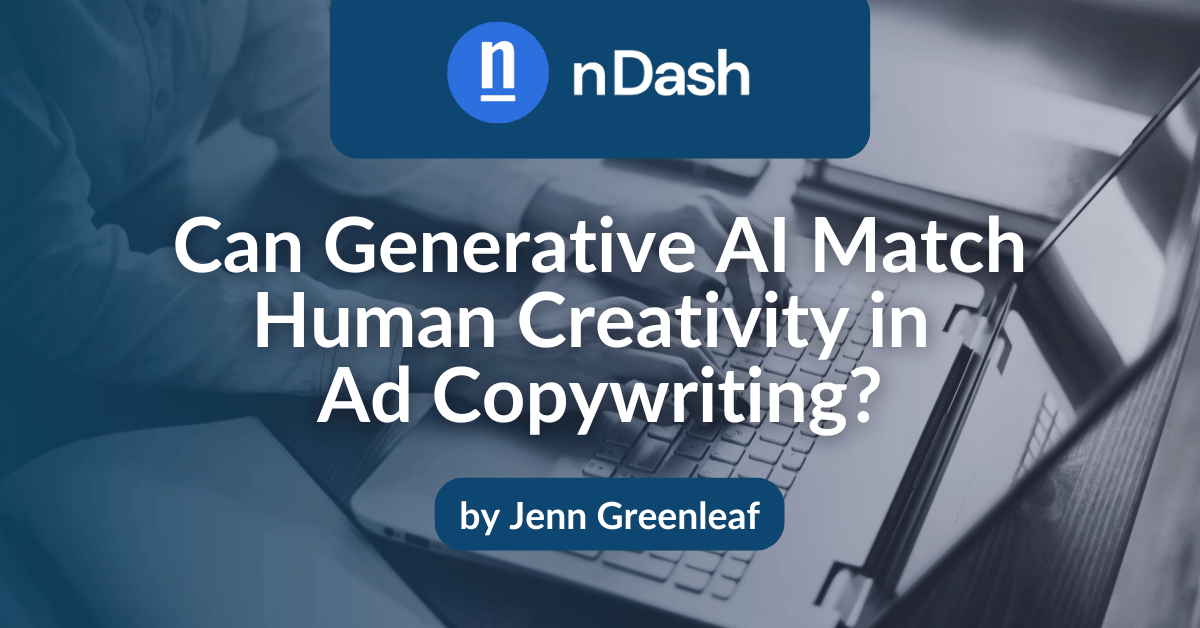Human vs. AI copywriting: which drives higher clicks & conversions? Search Engine Journal’s data reveals the surprising truth.
The Click-Through Conundrum: AI vs. Human Copywriting
Click-through rates (CTR) and cost per click (CPC) are pivotal metrics in assessing the performance of online advertisements. A high CTR indicates that the ad content resonates well with the audience, prompting them to click on the ad, while CPC measures the cost-effectiveness of these clicks. For instance, in 2024, the average CPC for Google Ads is $4.66, with significant variations across industries.
The debate between human-generated ad copy and AI-generated ad copy is increasingly relevant as both aim to maximize CTR and minimize CPC. Because humans understand the audience on a deeper level, their ads can be more relatable.
Despite AI’s rapid advancements, its ability to understand and emotionally connect with audiences remains limited. This gap suggests that while AI can support and enhance ad copy creation, human involvement is crucial for crafting compelling and contextually relevant messages.
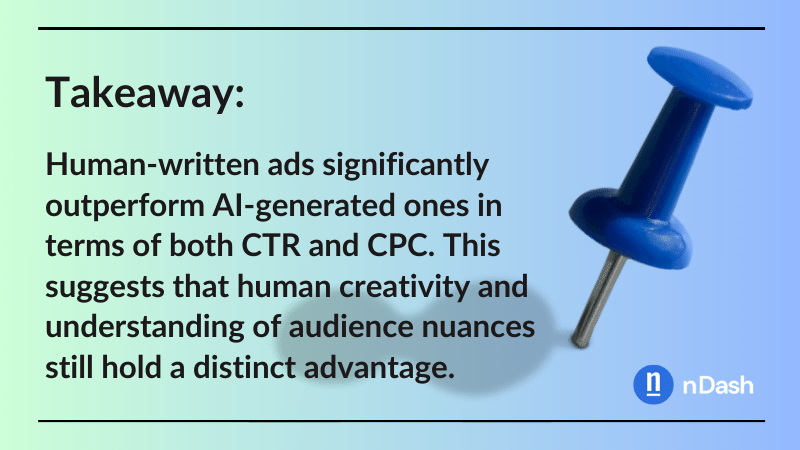
💡 Action items:
- Analyze your current ad performance metrics: Compare CTR and CPC for human-written and AI-generated ads.
- Conduct A/B Testing: Test both human-written and AI-generated ad copies to see which performs better for your specific audience.
- Optimize ad copy: Based on performance data, continuously refine and optimize your ad copy to improve CTR and reduce CPC.
Human Copywriting Beats AI-Generated Ads: A Data Study
The study mentioned above aimed to assess the effectiveness of human-written versus AI-generated ad copy using Copy AI, an AI-powered copy-generation platform. The target audience for this study included business owners and marketing managers seeking pay-per-click advertising services.
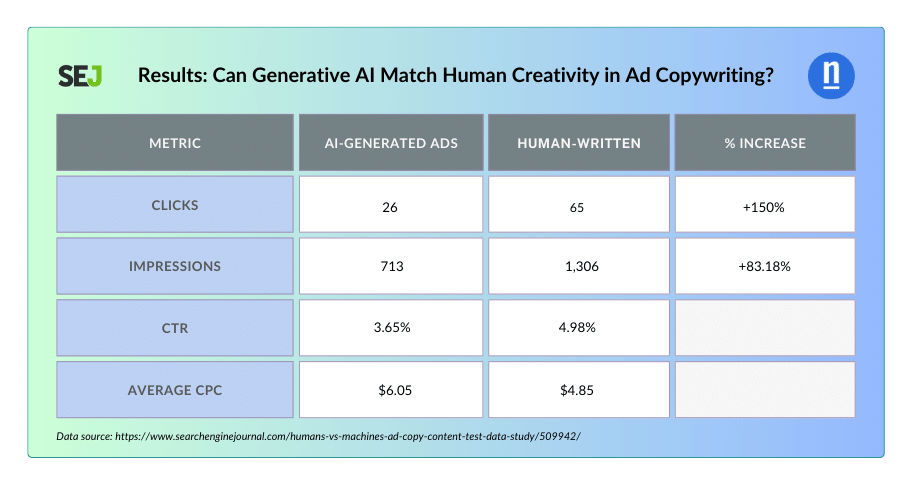
Results: Numbers Don’t Lie
Search Engine Journal (SEJ) adhered to Google’s best practices by creating responsive search ads (RSAs) that featured 15 headlines and four descriptions for each ad, both for human and AI-generated content.
The ads were placed on Google search via Google Ads for eight weeks, with a budget of $500. This setup enabled a detailed analysis of clicks, impressions, CTR, and average CPC.
Human-written ads achieved 45.41% more impressions and 60% more clicks than AI-generated ads. CTR for human ads was 4.98%, significantly higher than AI’s 3.65%. The average CPC for human ads was $4.85, lower than AI’s $6.05.
The results of SEJ’s study clearly demonstrated the superiority of human-written ad copy over AI-generated content. Key metrics such as clicks, impressions, CTR, and average CPC highlighted the performance differences between human-written and AI-generated ads.
💡 Action items:
- Monitor key metrics: Regularly track key performance metrics like clicks, impressions, CTR, and CPC to evaluate the effectiveness of your ads.
- Performance benchmarking: Benchmark your ad performance against industry standards to identify areas for improvement.
- Iterative improvements: Based on performance data, implement iterative improvements to your ad copy to achieve better results over time.
Analysis: Why Humans Outperform AI
The notable performance gap between human-written and AI-generated ad copy can be attributed to several key factors that highlight the unique capabilities of human creativity and understanding.
1. Understanding Audience Emotions, Needs, and Desires
Human copywriters excel in understanding the audience’s emotions, needs, and desires, allowing them to craft resonant messages. This nuanced understanding helps address specific pain points and motivations. It enables intuitive adjustments in tone and language to evoke empathy, urgency, or excitement. Consequently, this emotional connection often results in higher engagement and click-through rates.
2. The Power of Human Creativity and Emotional Appeal
AI copywriting is growing in popularity, but it can’t replace human copywriters. Why? Because humans understand the power of emotions and storytelling. We can use humor to disarm, weave narratives to captivate, and create a sense of urgency that compels action.
Imagine an ad with a perfectly timed joke that sticks in your mind or a heartwarming story that makes you connect with the brand. That’s the kind of impact a human copywriter can create, driving clicks and building lasting brand loyalty.
3. Limitations of AI in Handling Nuanced Language and Cultural References
AI-generated content often fails to handle the subtleties of language and cultural nuances. For example, AI can generate grammatically correct and contextually relevant text. But, it can’t understand and incorporate cultural references or idiomatic expressions that resonate with specific audiences.
This limitation can result in generic and less engaging content. Human copywriters, on the other hand, can seamlessly integrate cultural touchpoints and language nuances. Therefore, their content is more relatable and effective.
4. Dependence of AI-Generated Content on Training Data Quality
If training data is limited or biased, the AI’s output will likely reflect those shortcomings. For example, AI trained on outdated or non-diverse data sets may produce content that is not only less relevant but also potentially insensitive or inappropriate for certain audiences. Human writers can draw from a broader range of experiences and knowledge, allowing them to produce more accurate and culturally aware content.
5. Human Adaptability in Tailoring Messages to Specific Contexts and Platforms
Humans have an innate ability to adapt their messaging to suit specific contexts and platforms. For maximum reach and impact, ad copy needs to be adaptable to different media formats. For instance, a message crafted for a social media platform like Instagram might differ significantly from one designed for a professional network like LinkedIn.
Human copywriters can modify their tone, style, and content structure to align with the unique expectations and behaviors of each platform’s audience. This tailored approach often results in higher engagement and better overall performance.
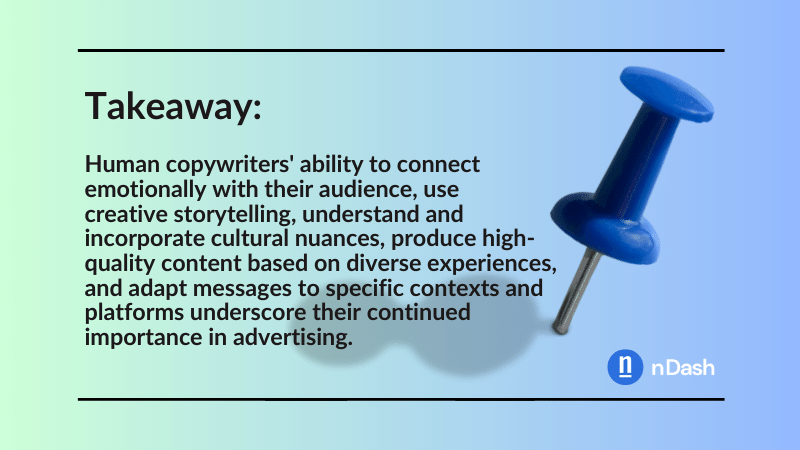
💡 Action items:
- Leverage emotional appeal: Train your copywriters to focus on understanding and leveraging the emotional needs of your target audience.
- Enhance creativity: Encourage your copywriters to incorporate creative storytelling and humor into their ad copy.
- Cultural relevance: Ensure your copywriters are aware of cultural nuances and language subtleties that can make your ads more relatable.
Optimizing the AI Advantage: Using AI Responsibly
AI tools offer numerous benefits when used strategically in copywriting. They can significantly enhance productivity, provide creative suggestions, and handle repetitive tasks efficiently. However, maximizing these advantages requires a thoughtful approach.
AI-generated content should always undergo careful human review and editing to ensure quality and consistency. Human oversight is essential to correct errors, enhance readability, and ensure the content aligns with your brand voice. This step also involves tweaking the AI-generated content to make it more relatable and emotionally appealing.
Ethical Considerations in AI-Generated Content
AI-generated content requires responsible use to ensure it is accurate, transparent, and avoids manipulation. Ethical considerations are paramount to maintaining trust and credibility.
- Accuracy and transparency: Ensuring the accuracy of AI-generated content is critical. AI tools should be programmed to fact-check and cross-reference information from reliable sources. Transparency involves clearly disclosing when content is AI-generated, helping to maintain trust with your audience. For instance, content should be labeled as AI-generated to avoid misleading readers about the source and nature of the information.
- Avoiding deception and manipulation: AI-generated content should not be used to deceive or manipulate audiences. This includes avoiding the creation of fake reviews, misleading advertisements, or content that misrepresents facts. Ethical AI usage involves creating honest and authentic content that serves the best interests of your audience and maintains your brand’s integrity.
- Respecting user privacy: Respecting user privacy is another critical ethical consideration. Prioritize data privacy by complying with regulations and anonymizing personal information. This includes obtaining necessary consent and being transparent about how user data is collected and used.
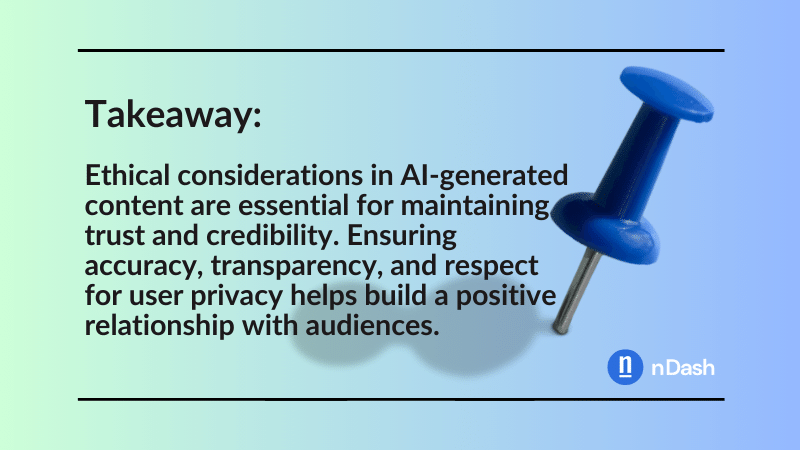
💡 Action items:
- Ensure accuracy: Implement processes to verify the accuracy of AI-generated content through fact-checking and cross-referencing reliable sources.
- Maintain transparency: Clearly disclose when content is AI-generated to maintain transparency and trust.
- Protect user privacy: Adhere to data protection regulations and ensure user data is anonymized and handled responsibly.
The Human Touch Endures: The Future of Advertising
The key takeaway from SEJ’s study and analysis is the undeniable value that human copywriters bring to crafting emotionally engaging narratives. Human creativity, empathy, and understanding of complex human emotions enable copywriters to create compelling stories that resonate deeply with audiences.
These narratives often go beyond mere information, tapping into the feelings, desires, and aspirations of the target audience, which significantly enhances engagement and conversion rates.
Emotional and Cultural Nuances
Human copywriters excel in creating content that is not only informative but also rich with emotional appeal. Their ability to understand cultural nuances, context, and the subtleties of language allows them to tailor messages that are highly relevant and impactful. This human touch in advertising ensures that the content feels genuine and relatable, fostering stronger connections with consumers.
AI tools can handle repetitive tasks, provide data-driven insights, and generate content ideas at scale. These capabilities free up human copywriters to focus on what they do best: creating emotionally rich and strategically crafted narratives.
AI as a Support Tool
AI can assist in optimizing content for SEO, analyzing consumer behavior, and personalizing ads to more effectively target specific demographics. When used responsibly, AI enhances the efficiency and effectiveness of advertising campaigns, providing valuable support to human copywriters without overshadowing their essential contributions.
The future of advertising isn’t human vs. AI. It’s human creativity and AI analysis. Will AI unlock innovative strategies that combine human creativity with AI’s analytical muscle? That remains to be seen. We know AI won’t replace human creativity. But it may become a tool that helps copywriters unlock insights that they hadn’t thought of before.
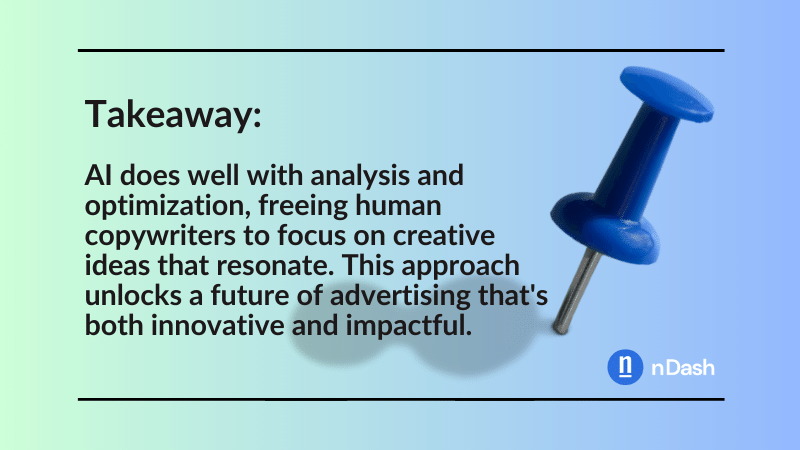
💡 Action items:
- Invest in human creativity: Continue to invest in training and developing your human copywriters to enhance their creativity and effectiveness.
- Use AI as a support tool: Leverage AI tools to handle repetitive tasks and provide data-driven insights, allowing your copywriters to focus on creative and strategic work.
- Monitor trends: Stay informed about developments in AI technology and advertising trends to adapt your strategies.
Generative AI: A Tool to Enhance, Not Replace
This analysis highlights the undeniable value of human copywriting in crafting emotionally resonant ad campaigns. Human understanding of audience needs and the ability to weave compelling narratives are key differentiators. While AI offers promising capabilities in content generation and analysis, it currently lacks the human touch that fosters genuine connections with consumers.
As AI technology evolves, it will likely become a more sophisticated tool to support human creativity, but for now, human copywriters remain the driving force behind effective advertising. Businesses that prioritize ad copy that resonates and converts should leverage the power of human creativity in their marketing strategies.
